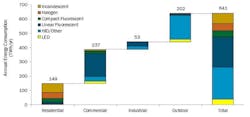US DOE publishes Lighting Market Characterization documenting SSL march
Detailing installed lighting in the US of all types of sources, total energy use, and total lumen output, the newest US Department of Energy (DOE) report will help guide the agency’s R&D program.
The US Department of Energy (DOE) has just published its third-ever “US Lighting Market Characterization” (LMC) report that the agency uses in part to guide its research and development (R&D) program. The report documents the installed base, total energy used, and lumen output of all general lighting products operating in the US, with the new report covering that data as of the end of 2015.
Interested in articles & announcements on SSL R&D?
The most recent LMC was published in 2012 and covered the market as of the end of 2010. At that time, the installed base of solid-state lighting (SSL) was nascent and the energy savings relative to lighting that were reported in the document were mostly tied to adoption of compact fluorescent lamps (CFLs) in place of incandescent lamps, and transition from T12 fluorescent tubes to T8 and T5 tubes.
The new report provides a much better indication of the impact of LEDs on the general lighting market, although it also clearly states that LEDs had only penetrated 8% of the total installed base at the end of 2015. Still, the electrical use today for all types of lighting is 641 TWh or 17% of the total electricity used in the US. Back in 2012, the report stated that lighting accounted for 700 TWh of electricity or 19% of total energy used.
The report digs much deeper and individually characterizes the residential, outdoor, commercial, and industrial sectors. Moreover, the data is broken down by lamp and luminaires types as well as the type of light sources installed. Outdoor lighting enjoyed the highest SSL penetration in 2015 at 23%.
One other interesting point was noted by Jim Brodrick, the director of the DOE SSL program. Many have feared that more energy-efficient products would simply lead society to install and use more lighting — an effect that has been called the lighting paradox or the rebound effect.
The DOE’s newly-released update on Lighting Market Characterization through the end of 2015 shows that outdoor lighting has seen the greatest penetration of LEDs since the 2012 report.
Brodrick noted, however, that the total number of lamps and luminaires installed in the US grew only from 8.2 billion in 2010 to 8.7 billion in 2015. And that growth is attributed to new households as opposed to more lighting in each household. The report in 2012 had reported a much larger jump that coincided with the efficiency afforded by fluorescent technology.
The report will be used by the US government in establishing funding programs and regulatory policy as well as by non-government organizations. The results are both encouraging in that there is tremendous opportunity for further savings and SSL deployment is headed in the right direction, and challenging in that the SSL industry needs to continue to push efficacy and keep the SSL installation trend accelerating.
You can download the full report on the DOE SSL website. Moreover, the agency is making available downloadable spreadsheets that include much of the data in the report.
The DOE has certainly been instrumental in driving the SSL revolution in the US and around the globe. Research such as the recent report on tunable lighting in schools illustrate the potential of new functionality that LEDs bring to applications and the technical challenges that stand in the way. The agency has also funded and researched OLED technology and applications. And the DOE continues R&D funding in both LED and OLED advancement.

Maury Wright | Editor in Chief
Maury Wright is an electronics engineer turned technology journalist, who has focused specifically on the LED & Lighting industry for the past decade. Wright first wrote for LEDs Magazine as a contractor in 2010, and took over as Editor-in-Chief in 2012. He has broad experience in technology areas ranging from microprocessors to digital media to wireless networks that he gained over 30 years in the trade press. Wright has experience running global editorial operations, such as during his tenure as worldwide editorial director of EDN Magazine, and has been instrumental in launching publication websites going back to the earliest days of the Internet. Wright has won numerous industry awards, including multiple ASBPE national awards for B2B journalism excellence, and has received finalist recognition for LEDs Magazine in the FOLIO Eddie Awards. He received a BS in electrical engineering from Auburn University.





![The DesignLights Consortium continues to make progress in shifting outdoor lighting products and implementation practices toward a more restrained and thoughtful strategy. [Image does not represent a DLC qualified fixture.] The DesignLights Consortium continues to make progress in shifting outdoor lighting products and implementation practices toward a more restrained and thoughtful strategy. [Image does not represent a DLC qualified fixture.]](https://img.ledsmagazine.com/files/base/ebm/leds/image/2024/08/66be810888ae93f656446f61-dreamstime_m_265700653.png?auto=format,compress&fit=&q=45&h=139&height=139&w=250&width=250)